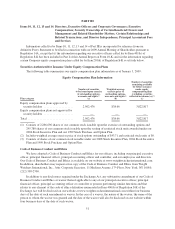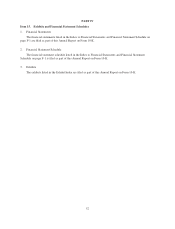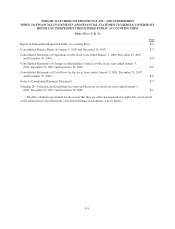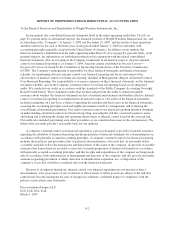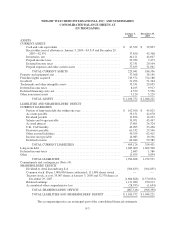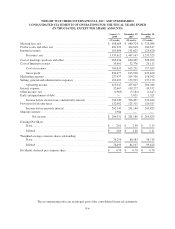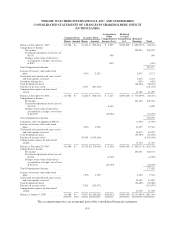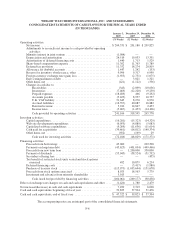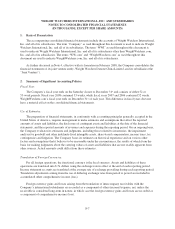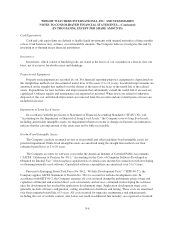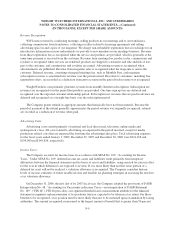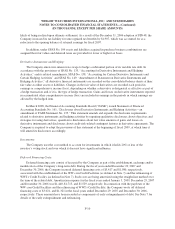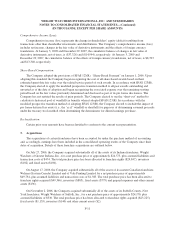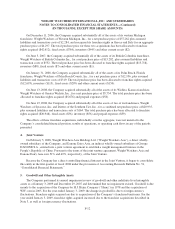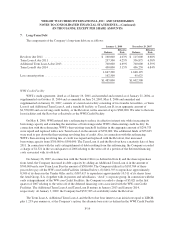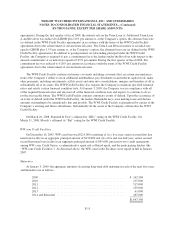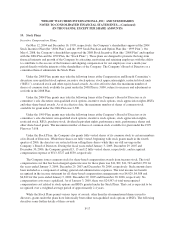WeightWatchers 2008 Annual Report Download - page 73
Download and view the complete annual report
Please find page 73 of the 2008 WeightWatchers annual report below. You can navigate through the pages in the report by either clicking on the pages listed below, or by using the keyword search tool below to find specific information within the annual report.WEIGHT WATCHERS INTERNATIONAL, INC. AND SUBSIDIARIES
NOTES TO CONSOLIDATED FINANCIAL STATEMENTS—(Continued)
(IN THOUSANDS, EXCEPT PER SHARE AMOUNTS)
Cash Equivalents:
Cash and cash equivalents are defined as highly liquid investments with original maturities of three months
or less. Cash balances may, at times, exceed insurable amounts. The Company believes it mitigates this risk by
investing in or through major financial institutions.
Inventories:
Inventories, which consist of finished goods, are stated at the lower of cost or market on a first-in, first-out
basis, net of reserves for obsolescence and shrinkage.
Property and Equipment:
Property and equipment are recorded at cost. For financial reporting purposes, equipment is depreciated on
the straight-line method over the estimated useful lives of the assets (3 to 10 years). Leasehold improvements are
amortized on the straight-line method over the shorter of the term of the lease or the useful life of the related
assets. Expenditures for new facilities and improvements that substantially extend the useful life of an asset are
capitalized. Ordinary repairs and maintenance are expensed as incurred. When assets are retired or otherwise
disposed of, the cost and related depreciation are removed from the accounts and any related gains or losses are
included in income.
Impairment of Long Lived Assets:
In accordance with the provisions of Statement of Financial Accounting Standards (“SFAS”) No. 144,
“Accounting for the Impairment or Disposal of Long-Lived Assets,” the Company reviews long-lived assets,
including amortizable intangible assets, for impairment whenever events or changes in business circumstances
indicate that the carrying amount of the assets may not be fully recoverable.
Goodwill and Intangible Assets:
The Company conducts an annual review of its goodwill and other indefinite-lived intangible assets for
potential impairment. Finite-lived intangible assets are amortized using the straight-line method over their
estimated useful lives of 3 to 20 years.
The Company accounts for software costs under the American Institute of Certified Public Accountants
(“AICPA”) Statement of Position No. 98-1, “Accounting for the Costs of Computer Software Developed or
Obtained for Internal Use,” which requires capitalization of certain costs incurred in connection with developing
or obtaining internally used software. Capitalized software expenditures are amortized over 3 to 5 years.
Pursuant to Emerging Issues Task Force No. 00-2, “Website Development Costs” (“EITF 00-2”), the
Company applies AICPA Statement of Position No. 98-1 to account for website development costs. In
accordance with EITF 00-2, the Company expenses all costs incurred during the preliminary project stage and
capitalizes all internal and external direct costs of materials and services consumed in developing the software,
once the development has reached the application development stage. Application development stage costs
generally include software configuration, coding, installation to hardware and testing. These costs are amortized
over their estimated useful life of 3 years. All costs incurred for upgrades, maintenance and enhancements,
including the cost of website content, which does not result in additional functionality, are expensed as incurred.
F-8



